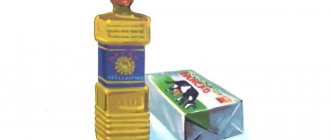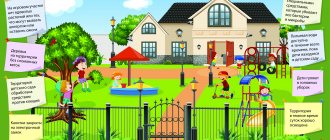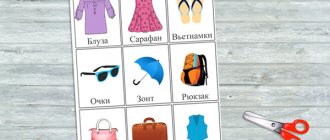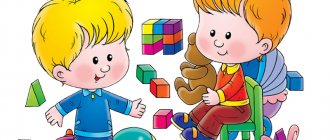Date: March 23, 2021 Author: Irina Gift Category: School
The ability to distinguish good from bad is one of the most important components of interpersonal relationships. After all, the freedom of one person ends where the freedom of another begins. Preschool and primary school age are years of active socialization, when a child learns to interact effectively with other people without violating their personal boundaries. To assess how adequate the child’s ideas about morality are, the method of R. R. Kalinina “Story Pictures” is used.
Methodology “Story Pictures”: author, essence, purpose
The author of the method, Rumiya Rashidovna Kalinina, a candidate of psychological sciences from Pskov, is developing programs to help children with deviations associated with mental reactions to the world around them, and helps in normalizing family relationships. The “Story Pictures” test is used to study children of preschool and primary school age’s understanding of moral standards of behavior. Children 4–5 years old are individually offered pairs of pictures that present scenes illustrating the following concepts:
- generosity and greed;
- responsiveness and indifference;
- friendliness and conflict;
- neatness and untidiness.
For children 6–8 years old, the pair “politeness - inattention” is added. The test takers' task is to classify the images into two piles: positive actions and negative ones.
Without a deep moral feeling, a person can have neither love nor honor - nothing that makes a person a person.
Vissarion Grigorievich Belinsky, literary critic of the 19th century
Without understanding basic norms of behavior, a child will not be able to go through the stage of socialization among peers.
Teaching children storytelling using a series of story pictures.
Teaching children storytelling using a series of story pictures.
When working with children when teaching storytelling based on a series of story pictures, educators use a number of teaching methods and techniques.
Visual methods. Pictures are visual objects of learning; children look at them both during classes and in everyday life. Looking at pictures is an indirect visual method and is used in kindergarten and for secondary familiarization with an object, consolidating knowledge acquired during observation, and forming coherent speech.
In the process of teaching preschoolers, methods such as looking at pictures with content familiar to children, looking at toys (as conventional images that reflect the world around them in three-dimensional pictorial forms), describing pictures and toys by children, and inventing plot stories are used. Of course, in all these processes, the teacher’s word is necessarily assumed, which guides the children’s perception, explains and names what is being shown. The source that determines the range of conversations and reasoning between the teacher and the children are individual paintings and series of plot paintings.
Verbal methods are used less often in kindergarten than in school. In kindergarten, mainly those verbal methods that are associated with artistic expression are used.
When examining series of plot paintings, the teacher’s story method is used; in older groups, the conversation method is used to consolidate previously communicated knowledge and to accustom them to collective conversation [14, p.187].
Verbal methods in their so-called pure form are used very rarely in kindergarten. The age-related characteristics of preschoolers require reliance on clarity, therefore, in all verbal methods, visual teaching methods are used (short-term display of an object, toys, looking at illustrations).
The purpose of practical methods is to teach children to apply acquired knowledge in practice, to help them acquire and improve their speech skills. In kindergarten, practical methods are most often playful in nature. Didactic game (with visual material and verbal) is a universal method of consolidating knowledge and skills. It is used to solve all speech development problems.
Each method is a set of techniques used to solve didactic problems (introduce new things, consolidate a skill or skill, creatively rework what has been learned)
A technique is an element of a method. Currently, the methodology of speech development, like general didactics, does not have a stable classification of techniques. First of all, they can be divided according to the role of clarity and emotionality into verbal, visual, and playful. In order for the children to better understand the content of the paintings, the teacher conducts a preliminary conversation with them, in which the children’s personal experience and memories of events similar to those depicted in the painting are used. When examining the painting “Autumn” from the “Our Tanya” series, the teacher draws attention to the multi-colored bouquet of autumn leaves. This causes revival in children, a certain emotional mood, as it is associated with vivid life experiences: they themselves collected yellow leaves and made bouquets from them. The transition from the introductory conversation to viewing the picture itself should be logically consistent and smooth. The questions “Who do you see in the picture?”, “What is the girl carrying in her hand?” The teacher turns the children's attention to the picture, immediately highlighting the central image in it. Children look with interest at a girl with a bouquet of the same autumn leaves that they themselves recently collected.
The teacher’s questions are the main methodological technique; they help children most accurately determine the properties and qualities of objects. In this case, the teacher’s questions help the kids reveal the girl’s mood - they saw her smile and understood why the girl was happy.
The teacher’s questions encourage children not only to identify objects and their qualities, but also to explain phenomena that are understandable to the child (Where did the leaves from the bushes go? - “They fell on the grass”). The analysis of the autumn landscape does not take place in isolation from the actions of the hero, but in close connection, which ensures the integrity of the perception of the picture. Question “Where did the girl collect leaves?” at the same time maintained interest in the main character and highlighted new aspects of the picture.
The transition from the analysis of one group of facts to the analysis of another should not violate the integrity of the perception of the picture. “A girl walks in the garden in autumn. How did she dress for the walk?” - With these words, the teacher switches the children’s attention to the description of the girl’s clothes. The children not only name items of clothing, but also explain why they dress warmly in the fall.
Thus, the sequence of questions ensures the integrity of the perception of the picture and helps children draw the correct conclusion: “It’s fun for a girl to walk in the garden in the fall” [9, p.84].
Not only the teacher’s questions play an important role, but also his statements, which summarize children’s answers and serve as a model for constructing sentences. The teacher not only synthesizes children's impressions, but also with emotionally charged words enhances the impact of the picture on children. He introduces new words and phrases, shows children the process of word formation (the leaves are yellow - the leaves turn yellow), and gives an example of an accurate and expressive statement. The teacher’s speech focuses the children’s attention on the picture even more; when they look at it again, new words and phrases are fixed in their memory.
The lesson should end with a summary story from the teacher. This gives the children the opportunity to once again listen to the words and phrases that the teacher previously included in his questions and explanations (“In the garden, the leaves on the trees have turned yellow. Yellow leaves are falling from the trees and bushes. The leaves are turning yellow all around. The Christmas tree is turning green in the garden,” etc. ).
Activation of coherent statements in children's speech is achieved in various ways and is carried out taking into account the age capabilities of preschoolers, as well as the originality of the pictures themselves.
The teacher’s story, which serves as a speech model for children, plays a huge role. The quality of this sample in each specific case must be given the greatest attention.
The painting “Riding a Horse” (from the “We Play” series) provides material for interesting, meaningful statements by children. The display of the painting can be combined with the display of a toy horse.
The teacher's lively, meaningful and at the same time laconic story helps preschoolers comprehend the content of a multi-subject plot picture and understand the relationships of the characters. Children see in practice how the content of a picture can be conveyed orally and learn to relate the story to the picture.
In senior groups, during classes on speech development, paintings published as educational visual aids for kindergartens are widely used. The goal of teaching remains the same - to teach children to describe what is depicted in the picture [5, p.39].
Children develop the skills to independently describe a picture, which develop and improve in the older group. At this age, one of the main methodological techniques is asking questions from the teacher.
Questions should be formulated in such a way that, when answering them, the child learns to construct detailed, coherent statements, and not limit himself to one or two words. (A detailed answer may consist of several sentences.) Excessively detailed questions teach children to give one-word answers. Questions that are not clearly stated also hinder the development of children's speech skills.
It must be borne in mind that relaxed, free statements allow children to more vividly express their impressions of what they see, therefore, when looking at pictures, you should eliminate everything that would entail constraint in children’s statements and reduce the emotional spontaneity of speech manifestations.
It is very important to purposefully train children in the ability to compose statements from several sentences of simple construction. For this purpose, in the process of viewing a plot picture, it is recommended to highlight certain objects for a detailed description of them, without at the same time violating the holistic perception. First, the teacher gives an example of a harmonious, concise, precise and expressive statement. Children, with the help of questions and instructions from the teacher, try to cope with the description of the next object, relying on a speech sample.
Thus, during painting classes, preschoolers practice constructing statements from several sentences united by a single content. They also learn to listen intently to the teacher's story based on the pictures, so that their experience of perceiving stories is gradually enriched. All this, undoubtedly, prepares children for independent composing of stories in the senior and preparatory groups.
The variety of methods and techniques used in working with preschoolers allows you to develop the child’s literate speech and the ability to operate with vocabulary by examining and describing a series of plot pictures used in a preschool institution.
Carrying out the R.R. test Kalinina among preschoolers and junior schoolchildren
To organize diagnostics, you will need a set of 8 (for children 4–5 years old) or 10 images (for 6–8 year old subjects), as well as a protocol in a form convenient for the experimenter. The testing algorithm is as follows:
- The child receives cards with pictures.
- The organizer defines the task: “Arrange the pictures in two piles so that one contains images of good deeds, and the other contains images of bad actions.”
- The adult also needs to stipulate the following: despite the lack of a time frame, you should not think too long about each card.
- After the baby classifies all the pictures, the adult will need to lay them out again in front of the subject and ask questions: “What is the boy’s mood?”, “Why do you think so?” For children 6 years old and older, only pairs 2, 3, 5 are offered, and the question is: “What do the characters in the pictures feel, do you think?”, “Why?”
The child’s explanations and his emotional reactions should be recorded in the protocol as we work with the images.
File: Stimulus material for diagnostics
A series of pictures for testing
Processing and interpretation of results
If the child did not cope well with the task, then you should think about contacting a psychologist.
Depending on the quality of the task, the child receives the following grades:
- 0 points - the pictures are arranged incorrectly, the child does not show an emotional reaction to the act depicted or refuses to answer;
- 1 point - the subject distributed the cards correctly, but could not give a rationale for the classification, there are also no emotional manifestations associated with the plot of the drawings, the child is not able to correlate the moods of the people in the illustrations with the situation;
- 2 points - the test taker correctly sorted the pictures and justified his choice, but emotions (despite all adequacy) are expressed very weakly;
- 3 points - the subject correctly laid out the drawings, explained the choice, named the ethical standard and showed adequate intensity of emotional reactions through facial expressions, gestures, and so on.
A score of 3 points is considered the norm. If the child uncertainly evaluates the depicted actions of the heroes and receives 2 points, then to correct the situation, psychologists advise reading more with the child and analyzing the actions of the heroes together with him. This way it will be easier for the little person to learn to evaluate both his own and others’ actions. If a child receives 1 point or even 0, you cannot do without the help of a specialist in developmental psychology.
Testing using the “Story Pictures” method does not require much time, and the result of such a simple diagnosis can be the first sign that the baby has any abnormalities. The technique will allow you to develop a strategy for corrective work with a particular subject in order to help him develop a harmonious personality.
Stimulus material for children of the younger group.The pictures present the following moral standards that are polar in their characteristics.
I. Kindness - greed:
1. the boy treats everyone with sweets from the box, smiles;
2. The girl covers all the toys from the children around her with her hands.
II. Responsiveness - indifference:
1. a little girl is crying, another one is comforting her; the expression on the second girl's face is sympathetic;
2. one boy is crying over a broken car, the other is pointing his finger at him and laughing.
III. Friendliness - conflict:
1. children play together and build a tower of cubes;
2. The boy takes the toy horse from the girl.
IV. Accuracy - inaccuracy:
1. the girl combs her hair in front of the mirror;
2. a girl in a dirty dress, unkempt, tears out pages from a book.
Presentation of tasks for children of the younger group.
Teacher’s instructions: “I will show you different pictures about children. Choose pictures in which children behave well and in which they behave badly.” The pictures are presented to the children in pairs. After the child has laid out the pictures, the teacher lays them all out in front of him again and asks him to show who is happy in the pictures and who is sad.
Stimulus material for children of middle and older groups.
To the four pairs of pictures used to diagnose children of the younger group, a fifth pair is added - politeness - inattention to adults:
1. the child offers the woman a chair, she smiles;
2. Grandmother sits sad, holding her head; the boy plays the drum, laughs.
Presentation of the task for children of the middle and senior groups.
After presenting each pair of pictures, children of senior preschool age are asked the question: “Why do you think so?”
After completing the first task, pictures II, III, V pairs are laid out in front of the child one by one and asked the questions “What is the mood of the people in this picture? How do you think they feel? Why?"
Processing the results.
0 points - the child arranges the pictures incorrectly (in one pile there are pictures with images of both positive and negative actions), emotional reactions are inadequate or absent. In older preschool age, the child incorrectly names the feelings of other people or refuses to answer this question.
1 point - the child arranges the pictures correctly, but cannot justify his actions; emotional manifestations when assessing actions are not expressed. An older preschooler cannot correlate the mood of people in the pictures with a specific situation or explain them.
2 points - by correctly arranging the pictures, the child justifies his actions, emotional reactions are adequate, but weakly expressed. The child correctly names people's feelings, but cannot always explain their reason.
3 points - the child correctly selects children’s actions and justifies his choice. In older preschool age, he names the moral norm; emotional reactions to the actions of the heroes of the situation are adequate and vivid.
For children of senior preschool age, diagnostic data are supplemented with the results of the “Finish the Story” technique.








